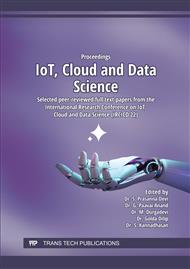[1]
H. F. Atlam and G. B. Wills, IoT Security, Privacy, Safety and Ethics,, in Internet of Things, Springer International Publishing, 2020, p.123–149.
DOI: 10.1007/978-3-030-18732-3_8
Google Scholar
[2]
Jinsi Jose and Deepa V.Jose, Performance Analysis of Deep Learning Algorithms for Intrusion Detection in IoT,, IEEE Access, (2021).
Google Scholar
[3]
J. M. Peterson, J. L. Leevy, and T. M. Khoshgoftaar, A Review and Analysis of the Bot-IoT Dataset,, in Proceedings - 15th IEEE Inernational Conference on Service-Oriented System Engineering, SOSE 2021, Aug. 2021, p.20–27.
DOI: 10.1109/sose52839.2021.00007
Google Scholar
[4]
R. Panigrahi and S. Borah, A detailed analysis of CICIDS2017 dataset for designing Intrusion Detection Systems Analysis of Selected Clustering Algorithms Used in Intrusion Detection Systems View project WEKA Result Reader-A Smart Tool for Reading and Summarizing WEKA Simulator Files View project A detailed analysis of CICIDS2017 dataset for designing Intrusion Detection Systems,, 2018. [Online]. Available: https://www.researchgate.net/publication/329045441.
DOI: 10.1007/978-981-15-5788-0_15
Google Scholar
[5]
L. Vu, Q. U. Nguyen, D. N. Nguyen, D. T. Hoang, and E. Dutkiewicz, Deep Transfer Learning for IoT Attack Detection,, IEEE Access, vol. 8, p.107335–107344, 2020,.
DOI: 10.1109/access.2020.3000476
Google Scholar
[6]
Y. Meidan et al., N-BaIoT: Network-based Detection of IoT Botnet Attacks Using Deep Autoencoders,, May 2018,.
DOI: 10.1109/mprv.2018.03367731
Google Scholar
[7]
I. Hafeez, M. Antikainen, A. Y. Ding, and S. Tarkoma, IoT-KEEPER: Detecting Malicious IoT Network Activity Using Online Traffic Analysis at the Edge,, IEEE Trans. Netw. Serv. Manag., vol. 17, no. 1, p.45–59, Mar. 2020,.
DOI: 10.1109/tnsm.2020.2966951
Google Scholar
[8]
S. Revathi and A. Malathi, A Detailed Analysis on NSL-KDD Dataset Using Various Machine Learning Techniques for Intrusion Detection,, 2013. [Online]. Available: www.ijert.org.
Google Scholar
[9]
N. Moustafa and J. Slay, UNSW-NB15: A comprehensive data set for network intrusion detection systems (UNSW-NB15 network data set),, Dec. 2015.
DOI: 10.1109/milcis.2015.7348942
Google Scholar
[10]
X. H. Nguyen, X. D. Nguyen, H. H. Huynh, and K. H. Le, Realguard: A Lightweight Network Intrusion Detection System for IoT Gateways,, Sensors, vol. 22, no. 2, Jan. 2022,.
DOI: 10.3390/s22020432
Google Scholar
[11]
M. Shafiq, Z. Tian, A. K. Bashir, X. Du, and M. Guizani, CorrAUC: A Malicious Bot-IoT Traffic Detection Method in IoT Network Using Machine-Learning Techniques,, IEEE Internet Things J., vol. 8, no. 5, p.3242–3254, Mar. 2021,.
DOI: 10.1109/jiot.2020.3002255
Google Scholar
[12]
K. Doshi, Y. Yilmaz, and S. Uludag, Timely Detection and Mitigation of Stealthy DDoS Attacks via IoT Networks,, IEEE Trans. Dependable Secur. Comput., 2021,.
DOI: 10.1109/tdsc.2021.3049942
Google Scholar
[13]
Y. N. Soe, Y. Feng, P. I. Santosa, R. Hartanto, and K. Sakurai, Machine learning-based IoT-botnet attack detection with sequential architecture,, Sensors (Switzerland), vol. 20, no. 16, p.1–15, Aug. 2020,.
DOI: 10.3390/s20164372
Google Scholar
[14]
S. Homayoun et al., DRTHIS: Deep ransomware threat hunting and intelligence system at the fog layer,, Futur. Gener. Comput. Syst., vol. 90, p.94–104, Jan. 2019,.
DOI: 10.1016/j.future.2018.07.045
Google Scholar
[15]
A. Azmoodeh, A. Dehghantanha, and K. K. R. Choo, Robust Malware Detection for Internet of (Battlefield) Things Devices Using Deep Eigenspace Learning,, IEEE Trans. Sustain. Comput., vol. 4, no. 1, p.88–95, Jan. 2019,.
DOI: 10.1109/tsusc.2018.2809665
Google Scholar
[16]
Y. Meidan et al., N-BaIoT-Network-based detection of IoT botnet attacks using deep autoencoders,, IEEE Pervasive Comput., vol. 17, no. 3, p.12–22, Jul. 2018,.
DOI: 10.1109/mprv.2018.03367731
Google Scholar
[17]
J. Bhayo, R. Jafaq, A. Ahmed, S. Hameed, and S. A. Shah, A Time-Efficient Approach Toward DDoS Attack Detection in IoT Network Using SDN,, IEEE Internet Things J., vol. 9, no. 5, p.3612–3630, Mar. 2022,.
DOI: 10.1109/jiot.2021.3098029
Google Scholar
[18]
J. Bhayo, S. Hameed, and S. A. Shah, An Efficient Counter-Based DDoS Attack Detection Framework Leveraging Software Defined IoT (SD-IoT),, IEEE Access, 2020,.
DOI: 10.1109/access.2020.3043082
Google Scholar
[19]
M. Roopak, G. Yun Tian, and J. Chambers, Deep learning models for cyber security in IoT networks,, in 2019 IEEE 9th Annual Computing and Communication Workshop and Conference, CCWC 2019, Mar. 2019, p.452–457.
DOI: 10.1109/ccwc.2019.8666588
Google Scholar
[20]
O. Brun, Y. Yin, and E. Gelenbe, Deep Learning with Dense Random Neural Network for Detecting Attacks against IoT-connected Home Environments,, in Procedia Computer Science, 2018, vol. 134, p.458–463.
DOI: 10.1016/j.procs.2018.07.183
Google Scholar
[21]
H. HaddadPajouh, A. Dehghantanha, R. Khayami, and K. K. R. Choo, A deep Recurrent Neural Network based approach for Internet of Things malware threat hunting,, Futur. Gener. Comput. Syst., vol. 85, p.88–96, Aug. 2018,.
DOI: 10.1016/j.future.2018.03.007
Google Scholar
[22]
J. Liu, D. Yang, M. Lian, and M. Li, Research on intrusion detection based on particle swarm optimization in IoT,, IEEE Access, vol. 9, p.38254–38268, 2021,.
DOI: 10.1109/access.2021.3063671
Google Scholar
[23]
A. Fatani, M. A. Elaziz, A. Dahou, M. A. A. Al-Qaness, and S. Lu, IoT Intrusion Detection System Using Deep Learning and Enhanced Transient Search Optimization,, IEEE Access, vol. 9, p.123448–123464, 2021,.
DOI: 10.1109/access.2021.3109081
Google Scholar


